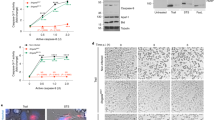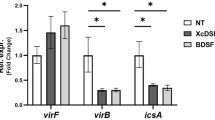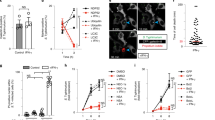Key Points
-
Gram-negative and Gram-positive pathogens use a common virulence strategy to increase the expression of Kruppel-like factor mammalian transcriptional regulators.
-
This strategy involves the subversion of host cell functions by secreting bacterial exotoxins using a type III secretion system or an alternative secretion mechanism.
-
Exploitation of the Kruppel-like factor regulatory cascade results in the modulation of numerous cell processes, including NFκB activation, pro-inflammatory cytokine expression, actin cytoskeletal dynamics, cell proliferation and phagocytosis.
-
The modulation of Kruppel-like factors 2 and 6 by diverse pathogens such as Pseudomonas aeruginosa, Yersinia enterocolitica, Clostridium botulinum and Staphylococcus aureus could involve a common mechanism based on altered activities of the Rho protein signalling cascade.
-
Increased expression of KLF2 by bacterial pathogens may be due to relief from repression of KLF2 by Rho-GTP, which may or may not involve NFκB, itself a negative regulator of KLF2 expression.
-
Analysis of the modular structure of the bacterial effector proteins indicates that enzymatic substrate specificity has an important role in the alteration of these transcriptional regulators.
-
Increased expression of Kruppel-like factors 2 and/or 6, as is seen in response to bacterial infection would result in decreased expression of NFκB and JUN, inhibition of phagocytosis, pro-inflammatory cytokines and cellular proliferation, ultimately to the detriment of the host.
Abstract
Diverse pathogenic bacteria have developed similar mechanisms to subvert host cell responses. In this Progress article, we focus on bacterial virulence factors with different enzymatic activities that can increase the expression of the Kruppel-like factor (KLF) family of mammalian transcriptional regulators through their ability to modify the activity of a common host-cell target — the Rho protein family. By using a common virulence strategy, both Gram-negative and Gram-positive pathogens exploit the KLF regulatory cascade to modulate nuclear factor κB activation, pro-inflammatory cytokine expression, actin cytoskeletal dynamics and phagocytosis.
This is a preview of subscription content, access via your institution
Access options
Subscribe to this journal
Receive 12 print issues and online access
$209.00 per year
only $17.42 per issue
Buy this article
- Purchase on Springer Link
- Instant access to full article PDF
Prices may be subject to local taxes which are calculated during checkout


Similar content being viewed by others
References
Martin J. Blaser . Statement of the Infectious Diseases Society of America concerning Project Bioshield reauthorization issues presented before the U. S. House Energy and Commerce Committee's Subcommittee on Health April 6, 2006. [online], (2006).
Spellberg, B. Trends in antimicrobial drug development: implications for the future Clin. Infect. Dis. 38, 1279–1286 (2004).
Suske, G., Bruford, E. & Philipsen, S. Mammalian SP/KLF transcription factors: bring in the family. Genomics 85, 551–556 (2005).
Jain, M. K. & Ridker, P. M. Anti-inflammatory effects of statins: clinical evidence and basic mechanisms. Nature Rev. Drug Discov. 4, 977–987 (2005).
van Vliet, J. et al. Human KLF17 is a new member of the Sp/KLF family of transcription factors. Genomics 87, 474–482 (2006).
Wani, M. A., Means, R. T., Jr & Lingrel, J. B. Loss of LKLF function results in embryonic lethality in mice. Transgenic Res. 7, 229–238 (1998).
Kuo, C. T. et al. The LKLF transcription factor is required for normal tunica media formation and blood vessel stabilization during murine embryogenesis. Genes Dev. 11, 2996–3006 (1997).
Kuo, C. T., Veselits, M. L. & Leiden, J. M. LKLF: A transcriptional regulator of single-positive T cell quiescence and survival. Science 277, 1986–1990 (1997).
Das, H. et al. Kruppel-like factor 2 (KLF2) regulates proinflammatory activation of monocytes. Proc. Natl Acad. Sci. USA 103, 6653–6658 (2006).
Haaland, R. E., Yu, W. & Rice, A. P. Identification of LKLF-regulated genes in quiescent CD4+ T lymphocytes. Mol. Immunol. 42, 627–641 (2005).
SenBanerjee, S. et al. KLF2 Is a novel transcriptional regulator of endothelial proinflammatory activation. J. Exp. Med. 199, 1305–1315 (2004).
Pahl, H. L. Activators and target genes of Rel/NF-kappaB transcription factors. Oncogene 18, 6853–6866 (1999).
Hayden, M. S. & Ghosh, S. Signaling to NF-kB. Genes Dev. 18, 2195–2224 (2004).
Kumar, A., Lin, Z., SenBanerjee, S. & Jain, M. K. Tumor necrosis factor α-mediated reduction of KLF2 is due to inhibition of MEF2 by NF-kB and histone deacetylases. Mol. Cell Biol. 25, 5893–5903 (2005).
Kojima, S. et al. Transcriptional activation of urokinase by the Kruppel-like factor Zf9/COPEB activates latent TGF-β1 in vascular endothelial cells. Blood 95, 1309–1316 (2000).
Kim, Y. et al. Transcriptional activation of transforming growth factor β1 and its receptors by the Kruppel-like factor Zf9/core promoter-binding protein and Sp1. Potential mechanisms for autocrine fibrogenesis in response to injury. J. Biol. Chem. 273, 33750–33758 (1998).
Narla, G. et al. KLF6, a candidate tumor suppressor gene mutated in prostate cancer. Science 294, 2563–2566 (2001).
Slavin, D. A. et al. A new role for the Kruppel-like transcription factor KLF6 as an inhibitor of c-Jun proto-oncoprotein function. Oncogene 23, 8196–8205 (2004).
Benzeno, S. et al. Cyclin-dependent kinase inhibition by the KLF6 tumor suppressor protein through interaction with cyclin D1. Cancer Res. 64, 3885–3891 (2004).
Chen, C. et al. Deletion, mutation, and loss of expression of KLF6 in human prostate cancer. Am. J. Pathol. 162, 1349–1354 (2003).
Kremer-Tal, S. et al. Frequent inactivation of the tumor suppressor Kruppel-like factor 6 (KLF6) in hepatocellular carcinoma. Hepatology 40, 1047–1052 (2004).
Reeves, H. L. et al. Kruppel-like factor 6 (KLF6) is a tumor-suppressor gene frequently inactivated in colorectal cancer. Gastroenterology 126, 1090–1103 (2004).
Ito, G. et al. Kruppel-like factor 6 is frequently down-regulated and induces apoptosis in non-small cell lung cancer cells. Cancer Res. 64, 3838–3843 (2004).
Narla, G. et al. Targeted inhibition of the KLF6 splice variant, KLF6 SV1, suppresses prostate cancer cell growth and spread. Cancer Res. 65, 5761–8768 (2005).
Hybiske, K., Ichikawa, J. K., Huang, V., Lory, S. J. & Machen, T. E. Cystic fibrosis airway epithelial cell polarity and bacterial flagellin determine host response to Pseudomonas aeruginosa. Cell Microbiol. 6, 49–63 (2004).
O'Grady, E. P., Mulcahy, H., O'Callaghan, J., Adams, C. & O'Gara, F. Pseudomonas aeruginosa infection of airway epithelial cells modulates expression of Kruppel-like factors 2 and 6 via RsmA-mediated regulation of type III exoenzymes S and Y. Infect. Immun. 74, 5893–5902 (2006).
Sauvonnet, N., Pradet-Balade, B., Garcia-Sanz, J. A. & Cornelis, G. R. Regulation of mRNA expression in macrophages after Yersinia enterocolitica infection. Role of different Yop effectors. J. Biol. Chem. 277, 25133–25142 (2002).
Hoffmann, R., van Erp, K., Trulzsch, K. & Heesemann, J. Transcriptional responses of murine macrophages to infection with Yersinia enterocolitica. Cell Microbiol. 6, 377–390 (2004).
Bohn, E. et al. Gene expression patterns of epithelial cells modulated by pathogenicity factors of Yersinia enterocolitica. Cell Microbiol. 6, 129–141 (2004).
Moreilhon, C. et al. Live Staphylococcus aureus and bacterial soluble factors induce different transcriptional responses in human airway cells. Physiol. Genomics 20, 244–255 (2005).
Sen-Banerjee, S. et al. Kruppel-like factor 2 as a novel mediator of statin effects in endothelial cells. Circulation 112, 720–726 (2005).
Bishop, A. L. & Hall, A. Rho GTPases and their effector proteins. Biochem. J. 348, 241–255 (2000).
Barbieri, J. T., Riese, M. J. & Aktories, K. Bacterial toxins that modify the actin cytoskeleton. Annu. Rev. Cell Dev. Biol. 18, 315–344 (2002).
Stebbins, C. E. Structural insights into bacterial modulation of the host cytoskeleton. Curr. Opin. Struct. Biol. 14, 731–740 (2004).
Aktories, K. & Barbieri, J. T. Bacterial cytotoxins: targeting eukaryotic switches. Nature Rev. Microbiol. 3, 397–410 (2005).
Viboud, G. I. & Bliska, J. B. Yersinia outer proteins: role in modulation of host cell signaling responses and pathogenesis. Annu. Rev. Microbiol. 59, 69–89 (2005).
Goehring, U. M., Schmidt, G., Pederson, K. J., Aktories, K. & Barbieri, J. T. The N-terminal domain of Pseudomonas aeruginosa exoenzyme S is a GTPase-activating protein for Rho GTPases. J. Biol. Chem. 274, 36369–36372 (1999).
Krall, R., Schmidt, G., Aktories, K. & Barbieri, J. T. Pseudomonas aeruginosa ExoT is a Rho GTPase-activating protein. Infect. Immun. 68, 6066–6068 (2000).
Vincent, T. S., Fraylick, J. E., McGuffie, E. M. & Olson, J. C. ADP-ribosylation of oncogenic Ras proteins by pseudomonas aeruginosa exoenzyme S in vivo. Mol. Microbiol. 32, 1054–1064 (1999).
Maresso, A. W., Baldwin, M. R. & Barbieri, J. T. Ezrin/radixin/moesin proteins are high affinity targets for ADP-ribosylation by Pseudomonas aeruginosa ExoS. J. Biol. Chem. 279, 38402–38408 (2004).
Sun, J. & Barbieri, J. T. Pseudomonas aeruginosa ExoT ADP-ribosylates CT10 regulator of kinase (Crk) proteins. J. Biol. Chem. 278, 32794–32800 (2003).
Prehna, G., Ivanov, M. I., Bliska, J. B. & Stebbins, C. E. Yersinia virulence depends on mimicry of host Rho-family nucleotide dissociation inhibitors. Cell 126, 869–880 (2006).
Yahr, T. L., Vallis, A. J., Hancock, M. K., Barbieri, J. T. & Frank, D. W. ExoY, an adenylate cyclase secreted by the Pseudomonas aeruginosa type III system. Proc. Natl Acad. Sci. USA 95, 13899–13904 (1998).
Tamma, G. et al. cAMP-induced AQP2 translocation is associated with RhoA inhibition through RhoA phosphorylation and interaction with RhoGDI. J. Cell Sci. 116, 1519–1525 (2003).
Dinges, M. M., Orwin, P. M. & Schlievert, P. M. Exotoxins of Staphylococcus aureus. Clin. Microbiol. Rev. 13, 16–34 (2000).
Huddleson, J. P., Ahmad, N., Srinivasan, S. & Lingrel, J. B. Induction of KLF2 by fluid shear stress requires a novel promoter element activated by a phosphatidylinositol 3-kinase-dependent chromatin-remodelling pathway. J. Biol. Chem. 280, 23371–23379 (2005).
Acknowledgements
This work was supported in part by grants awarded by the Higher Education Authority of Ireland (PRTLI programme), the Science Foundation of Ireland, the European Commission and the Health Research Board.
Author information
Authors and Affiliations
Corresponding author
Ethics declarations
Competing interests
The authors declare no competing financial interests.
Related links
Related links
DATABASES
Entrez Genome Project
FURTHER INFORMATION
Rights and permissions
About this article
Cite this article
O'Grady, E., Mulcahy, H., Adams, C. et al. Manipulation of host Kruppel-like factor (KLF) function by exotoxins from diverse bacterial pathogens. Nat Rev Microbiol 5, 337–341 (2007). https://doi.org/10.1038/nrmicro1641
Issue Date:
DOI: https://doi.org/10.1038/nrmicro1641



